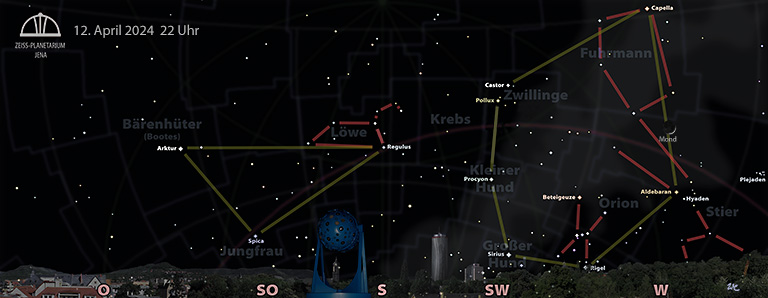Jupiter am Abend, Saturn am Morgen und Ostern
Die mittägliche Sonnenhöhe nimmt weiter zu und damit die Länge des hellen Tages auf knapp 15 Stunden.
Neumond ist am 8. und Vollmond am 24. April.
Am 25. März war der erste Frühlingsvollmond und somit ist am nächsten Montag, am 1. April, Ostermontag. Pfingsten folgt 7 Wochen später, am 19. Mai.
Den Riesenplaneten Jupiter können wir noch bis Ende April in der Abenddämmerung am nordwestlichen Horizont entdecken.
Im Südwesten – Westen neigen sich die Sterne des Wintersechsecks dem Horizont, dem Untergang entgegen.
Im Süden funkelt der Regulus im Trapez des Löwen. Östlich folgt der rötliche Arktur im Bootes oder Bärenhüter – darunter schließt die Spika in der Jungfrau das Frühlingsdreieck. Diese Sterne können gut mithilfe des Großen Wagens hoch im Zenit in seiner Frühlingsposition aufgefunden werden. Sein Deichselbogen weist direkt auf den Arktur und die Spika.
Am Morgenhimmel funkeln hoch im Osten bereits die hellen Sterne des Sommerdreiecks: Deneb – Wega – und Atair.
In der Morgendämmerung erscheint ab Monatsende im Osten der Ringplanet Saturn. Er bewegt sich rechtläufig, also von West nach Ost, vor dem Tierkreissternbild Wassermann.
W. Don Eck
Zeiss-Planetarium Jena
The starry sky in April 2024
Jupiter in the evening, Saturn in the morning and Easter
The midday height of the sun continues to increase and with it the length of the light day to just under 15 hours.
New moon is on 8 April and full moon on 24 April.
The first spring full moon was on 25 March and so next Monday, 1 April, is Easter Monday. Pentecost follows 7 weeks later, on 19 May.
We can still see the giant planet Jupiter in the evening twilight on the north-western horizon until the end of April.
In the south-west – west, the stars of the winter hexagon are leaning towards the horizon, towards the sunset.
In the south, Regulus sparkles in the Trapezium of Leo. To the east follows the reddish Arcturus in Bootes or Bear’s Keeper – below it, Spika in Virgo completes the spring triangle. These stars can be easily located with the help of the Big Dipper high in the zenith in its spring position. Its drawbar arc points directly to Arcturus and Spika.
In the morning sky, the bright stars of the Summer Triangle are already twinkling high in the east: Deneb – Vega – and Atair.
From the end of the month, the ringed planet Saturn appears in the east at dawn. It moves prograde, i.e. from west to east, in front of the zodiacal constellation of Aquarius.


